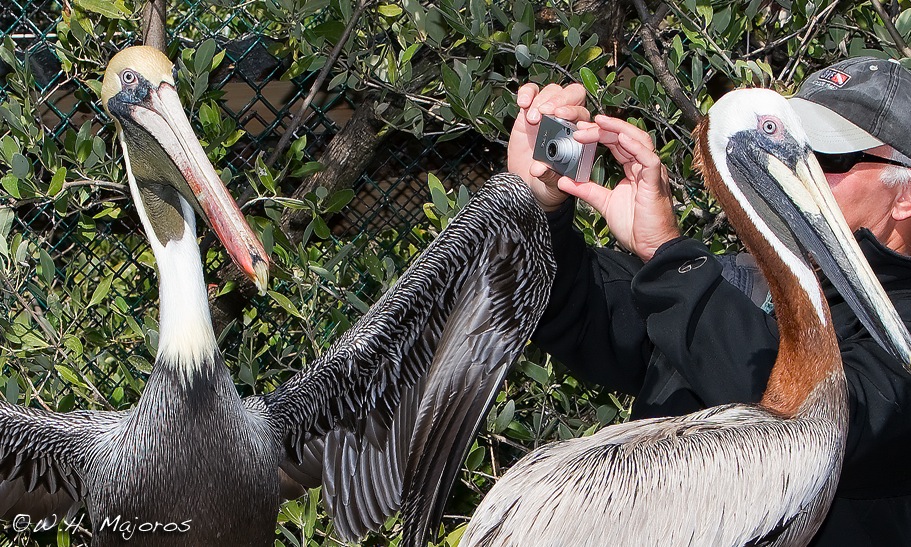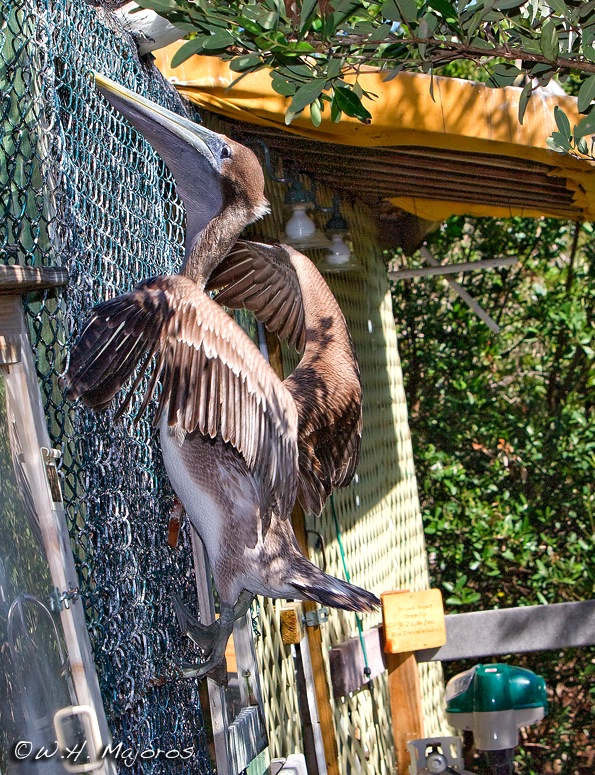March
2
Monday
1961
photos
|
This
morning after checking out of my hotel in Miami I headed straight to
the Wild Bird Center in Key Largo, since a photographer at Anhinga
Trail had suggested I try the Center in the mornings (which I hadn’t,
as of yet). I decided to just spend the entire day there, so that
I could also catch the 3:30pm feeding. This is my last day in the
Miami region, so after leaving here I’ll drive straight to my next
hotel, which is in Naples. At that point I’ll be leaving the
Everglades behind and birding some of the sites further north such as
Corkscrew Swamp and Sanibel Island.
As usual, feeding time at the Center was wonderful. As you can
see from the photo below, the egrets get very animated during this
time, and you can photograph them at literally point-blank range.
Though the sun is in a largely favorable position in the afternoon for
shooting the birds on the one side of the boardwalk, I still found it
useful to use lots of fill flash, by turning up the flash power to full
and using relatively slow shutter speeds. You can see that the
effect of lighting up a white bird with a combination of natural
sunlight and fill flash is quite striking:
Egrets at the
Wild Bird Center on Key Largo.
Canon 70-200mm f/2.8L lens at 70mm, f/8. 1/640 sec at ISO 160.
Fill flash on high-speed sync at full power (+3), no beamer.
Unfortunately, my flash unit, even with the external
battery pack connected (which adds 8 AA-batteries’ worth of juice),
can’t fire continuously at full power at ten frames per second (my
camera’s maximum frame rate), so after the first shot of a burst I
typically get five or six shots with little or no flash. Though I
strongly prefer the effect of fill flash, occasionally I get an image
that I’m satisfied with despite the lack of flash, such as the
following shot of a snowy egret:
Snowy Egret at
the Wild Bird Center.
70mm, f/8. 1/640 sec at ISO 160. No flash.
The use of fill flash can be augmented, or to some
degree even completely faked, in Photoshop. In the image below
(of a Great Egret in flight) my flash did not fire, though natural
sunlight illuminated most of the bird quite well. For the few
shadowy areas that the sunlight didn’t fully illuminate (such as the
uppermost portion of the bird’s neck) I lightened the shadows
artificially in postprocess. Lightening shadows is easy in
Photoshop — you just select the
region of interest, bring up the Shadows/Highlights
window, and then
play around with the Amount
and Tonal Width
sliders.
Great Egret at
the Wild Bird Center.
70mm at f/8. 1/640 sec at ISO 160. No flash.
For the image below, not only did the flash fire, but
I was lucky enough to have some wind blowing the bird’s feathers
around, which was an added bonus. Herons and egrets in breeding
plumage typically have long tassle-like feathers that blow around very
nicely in wind, and I make a point of trying to capture that effect
whenever possible. For the image below I also darkened the sky a
bit via Levels in Photoshop,
to make the bird stand out a bit more:
Snowy Egret at
the Wild Bird Center.
70mm at f/8. 1/640 sec at ISO 160.
Flash on high-speed sync at full power (+3). No beamer.
Although egrets can be photographed in flight in many
locations, what’s special about the Wild Bird Center on Key Largo is
that you can get photos of them coming in to perch. If the wind
is blowing or the bird changes its mind part-way through a landing
maneuver, you can get photos of them in interesting poses in
mid-air. Below is a fairly unremarkable example of the latter —
the bird has turned its body vertically in the air in order to slow
down as it approaches a perch:
Snowy Egret at
the Wild Bird Center.
70mm at f/8. 1/640 sec at ISO 160. No flash.
Out on the beach I finally got a few flight shots of
pelicans that I was more-or-less satisfied with. Though the angle
of sunlight isn’t ideal in the afternoon for shots of pelicans coming
in to land on the beach, occasionally you can get one banking in
mid-air and exposing its underside to the suns’ rays:
Brown Pelican at
the Wild Bird Center.
70mm at f/4.5. 1/640 sec at ISO 160.
Flash on high-speed sync at full power (+3).
I should note that for the image above I’m not
entirely satisfied with the colors, though I have no doubt this can be
fixed in Photoshop. Likewise, the blown highlights in the neck
and upper beak can, I’m
quite certain, also be fixed (whenever I get around to it...).
For the image below, the bird was so close that you can visually
untangle the fishing line wrapped around the bird’s leg —
for a photo
taken at 70mm focal length, that’s close indeed! I was actually
slapped in the face several times by the pelicans as they took off from
the boardwalk after feeding was over.
Brown Pelican at
the Wild Bird Center.
70mm at f/8. 1/640 sec at ISO 160.
Flash on high-speed sync at full power (+3).
In addition to the boardwalk and the beach, there
is also a small wetland habitat at the Wild Bird Center, though I
really didn’t fully explore the potential of this section of the
site. Below is a White Ibis that I shot in the morning with some
nice, colorful reflections in the shallow water:
White Ibis at the
Wild Bird Center.
200mm at f/9. 1/640 sec at ISO 200.
Fill flash on high-speed sync at full power (+3).
The birds in the wetland portion of the site were not
quite as approachable as some of those along the boardwalk, though all
of the birds that I photographed were wild
birds. Some of those
"wild" birds may, of course, be rehabilitated individuals which were
released but chose to stay in close proximity to the Center because of
the easy access to food. The bird below, a Yellow-crowned Night
Heron, is one such bird. Known affectionately as "YC" by the
staff, this bird has (if I remember correctly), returned to the Center
twice now after migrating away for the season:
Yellow-crowned
Night Heron at the Wild Bird Center.
200mm at f/8. 1/640 sec at ISO 100.
Flash on high-speed sync at full power (+3).
Apart from feeding time, most of the day that I spent
at the Wild Bird Center was fairly unproductive, so I’d recommend
limiting visits to the afternoon. During the morning hours the
only wild birds that I encountered were the ibises in the wetland area
and the pelicans that roamed the boardwalk alongside the human
visitors. Below is a shot of an extremely cooperative pelican
that sat contentedly on the boardwalk while I lay on my belly in front
of the bird while thrusting a wide-angle lens in its face:
Brown Pelicans on
the Boardwalk at the Wild Bird Center.
Canon 30D with Tokina 12-24mm wide-angle lens.
12mm at f/22. 1/400 at ISO 640. No flash.
Just to show you how cooperative the pelicans at the
Center are, here’s a photo of a visitor with a tiny point-and-shoot
camera getting a really close-up shot of a posing bird (unfortunately
for him, he’s shooting directly into the sun, so it’ll probably be a
really crappy photo anyway...):

Tourist
Photographing a Pelican.
70mm at f/11. 1/250 sec at ISO 200. Fill flash at full
power.
Finally, below
is probably the strangest bird photo I’ve ever taken. This
wild pelican was climbing the fence
using a combination of its feet, its
beak, and its wings. This is not a captive bird in a cage —
it’s a wild bird that was walking around on the boardwalk at the Center
and became alarmed at the sudden movement of one of the tourists (not
me). The bird flew into the fence bordering the walkway, and then
attempted to climb to the top of the fence where several other pelicans
were perched (not shown in the photo):

Wild Pelican
Climbing
a Fence.
70mm at f/8. 1/640 sec at ISO 160.
Fill flash on high-speed sync at full power.
A staff member heard the fence rattling and came out of the little
shack shown in the background, picked up the bird, and set it down on
the boardwalk. The staff member went back to work inside the
shack, and the bird resumed loitering on the boardwalk. And that
was that.
|